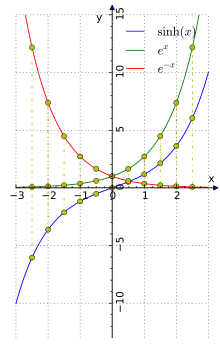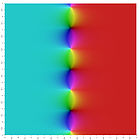Hyperbolic functions

In mathematics, hyperbolic functions are analogues of the ordinary trigonometric functions, but defined using the hyperbola rather than the circle. Just as the points (cos t, sin t) form a circle with a unit radius, the points (cosh t, sinh t) form the right half of the unit hyperbola. Also, similarly to how the derivatives of sin(t) and cos(t) are cos(t) and –sin(t) respectively, the derivatives of sinh(t) and cosh(t) are cosh(t) and +sinh(t) respectively.
Hyperbolic functions occur in the calculations of angles and distances in hyperbolic geometry. They also occur in the solutions of many linear differential equations (such as the equation defining a catenary), cubic equations, and Laplace's equation in Cartesian coordinates. Laplace's equations are important in many areas of physics, including electromagnetic theory, heat transfer, fluid dynamics, and special relativity.
The basic hyperbolic functions are:[1]
- hyperbolic sine "sinh" (/ˈsɪŋ, ˈsɪntʃ, ˈʃaɪn/),[2]
- hyperbolic cosine "cosh" (/ˈkɒʃ, ˈkoʊʃ/),[3]
from which are derived:[4]
- hyperbolic tangent "tanh" (/ˈtæŋ, ˈtæntʃ, ˈθæn/),[5]
- hyperbolic cotangent "coth" (/ˈkɒθ, ˈkoʊθ/),[6][7]
- hyperbolic secant "sech" (/ˈsɛtʃ, ˈʃɛk/),[8]
- hyperbolic cosecant "csch" or "cosech" (/ˈkoʊsɛtʃ, ˈkoʊʃɛk/[3])
corresponding to the derived trigonometric functions.
The inverse hyperbolic functions are:
- inverse hyperbolic sine "arsinh" (also denoted "sinh−1", "asinh" or sometimes "arcsinh")[9][10][11]
- inverse hyperbolic cosine "arcosh" (also denoted "cosh−1", "acosh" or sometimes "arccosh")
- inverse hyperbolic tangent "artanh" (also denoted "tanh−1", "atanh" or sometimes "arctanh")
- inverse hyperbolic cotangent "arcoth" (also denoted "coth−1", "acoth" or sometimes "arccoth")
- inverse hyperbolic secant "arsech" (also denoted "sech−1", "asech" or sometimes "arcsech")
- inverse hyperbolic cosecant "arcsch" (also denoted "arcosech", "csch−1", "cosech−1","acsch", "acosech", or sometimes "arccsch" or "arccosech")

The hyperbolic functions take a real argument called a hyperbolic angle. The size of a hyperbolic angle is twice the area of its hyperbolic sector. The hyperbolic functions may be defined in terms of the legs of a right triangle covering this sector.
In complex analysis, the hyperbolic functions arise when applying the ordinary sine and cosine functions to an imaginary angle. The hyperbolic sine and the hyperbolic cosine are entire functions. As a result, the other hyperbolic functions are meromorphic in the whole complex plane.
By Lindemann–Weierstrass theorem, the hyperbolic functions have a transcendental value for every non-zero algebraic value of the argument.[12]
Hyperbolic functions were introduced in the 1760s independently by Vincenzo Riccati and Johann Heinrich Lambert.[13] Riccati used Sc. and Cc. (sinus/cosinus circulare) to refer to circular functions and Sh. and Ch. (sinus/cosinus hyperbolico) to refer to hyperbolic functions. Lambert adopted the names, but altered the abbreviations to those used today.[14] The abbreviations sh, ch, th, cth are also currently used, depending on personal preference.
Notation
Definitions


There are various equivalent ways to define the hyperbolic functions.
Exponential definitions


In terms of the exponential function:[1][4]
- Hyperbolic sine: the odd part of the exponential function, that is,
- Hyperbolic cosine: the even part of the exponential function, that is,
- Hyperbolic tangent:
- Hyperbolic cotangent: for x ≠ 0,
- Hyperbolic secant:
- Hyperbolic cosecant: for x ≠ 0,
Differential equation definitions
The hyperbolic functions may be defined as solutions of differential equations: The hyperbolic sine and cosine are the solution (s, c) of the system with the initial conditions The initial conditions make the solution unique; without them any pair of functions would be a solution.
sinh(x) and cosh(x) are also the unique solution of the equation f ″(x) = f (x), such that f (0) = 1, f ′(0) = 0 for the hyperbolic cosine, and f (0) = 0, f ′(0) = 1 for the hyperbolic sine.
Complex trigonometric definitions
Hyperbolic functions may also be deduced from trigonometric functions with complex arguments:
- Hyperbolic sine:[1]
- Hyperbolic cosine:[1]
- Hyperbolic tangent:
- Hyperbolic cotangent:
- Hyperbolic secant:
- Hyperbolic cosecant:
where i is the imaginary unit with i2 = −1.
The above definitions are related to the exponential definitions via Euler's formula (See § Hyperbolic functions for complex numbers below).
Characterizing properties
Hyperbolic cosine
It can be shown that the area under the curve of the hyperbolic cosine (over a finite interval) is always equal to the arc length corresponding to that interval:[15]
Hyperbolic tangent
The hyperbolic tangent is the (unique) solution to the differential equation f ′ = 1 − f 2, with f (0) = 0.[16][17]
Useful relations
The hyperbolic functions satisfy many identities, all of them similar in form to the trigonometric identities. In fact, Osborn's rule[18] states that one can convert any trigonometric identity (up to but not including sinhs or implied sinhs of 4th degree) for , , or and into a hyperbolic identity, by expanding it completely in terms of integral powers of sines and cosines, changing sine to sinh and cosine to cosh, and switching the sign of every term containing a product of two sinhs.
Odd and even functions:
Hence:
Thus, cosh x and sech x are even functions; the others are odd functions.
Hyperbolic sine and cosine satisfy:
the last of which is similar to the Pythagorean trigonometric identity.
One also has
for the other functions.
Sums of arguments
particularly
Also:
Subtraction formulas
Also:[19]
Half argument formulas
where sgn is the sign function.
If x ≠ 0, then[20]
Square formulas
Inequalities
The following inequality is useful in statistics:[21]
It can be proved by comparing the Taylor series of the two functions term by term.
Inverse functions as logarithms
Derivatives
Second derivatives
Each of the functions sinh and cosh is equal to its second derivative, that is:
All functions with this property are linear combinations of sinh and cosh, in particular the exponential functions and .[22]
Standard integrals
The following integrals can be proved using hyperbolic substitution:
where C is the constant of integration.
Taylor series expressions
It is possible to express explicitly the Taylor series at zero (or the Laurent series, if the function is not defined at zero) of the above functions.
This series is convergent for every complex value of x. Since the function sinh x is odd, only odd exponents for x occur in its Taylor series.
This series is convergent for every complex value of x. Since the function cosh x is even, only even exponents for x occur in its Taylor series.
The sum of the sinh and cosh series is the infinite series expression of the exponential function.
The following series are followed by a description of a subset of their domain of convergence, where the series is convergent and its sum equals the function.
where:
- is the nth Bernoulli number
- is the nth Euler number
Infinite products and continued fractions
The following expansions are valid in the whole complex plane:
Comparison with circular functions

The hyperbolic functions represent an expansion of trigonometry beyond the circular functions. Both types depend on an argument, either circular angle or hyperbolic angle.
Since the area of a circular sector with radius r and angle u (in radians) is r2u/2, it will be equal to u when r = √2. In the diagram, such a circle is tangent to the hyperbola xy = 1 at (1,1). The yellow sector depicts an area and angle magnitude. Similarly, the yellow and red regions together depict a hyperbolic sector with area corresponding to hyperbolic angle magnitude.
The legs of the two right triangles with hypotenuse on the ray defining the angles are of length √2 times the circular and hyperbolic functions.
The hyperbolic angle is an invariant measure with respect to the squeeze mapping, just as the circular angle is invariant under rotation.[23]
The Gudermannian function gives a direct relationship between the circular functions and the hyperbolic functions that does not involve complex numbers.
The graph of the function a cosh(x/a) is the catenary, the curve formed by a uniform flexible chain, hanging freely between two fixed points under uniform gravity.
Relationship to the exponential function
The decomposition of the exponential function in its even and odd parts gives the identities and Combined with Euler's formula this gives for the general complex exponential function.
Additionally,
Hyperbolic functions for complex numbers
 |
 |
 |
 |
 |
 |
Since the exponential function can be defined for any complex argument, we can also extend the definitions of the hyperbolic functions to complex arguments. The functions sinh z and cosh z are then holomorphic.
Relationships to ordinary trigonometric functions are given by Euler's formula for complex numbers: so:
Thus, hyperbolic functions are periodic with respect to the imaginary component, with period ( for hyperbolic tangent and cotangent).
See also
- e (mathematical constant)
- Equal incircles theorem, based on sinh
- Hyperbolastic functions
- Hyperbolic growth
- Inverse hyperbolic functions
- List of integrals of hyperbolic functions
- Poinsot's spirals
- Sigmoid function
- Soboleva modified hyperbolic tangent
- Trigonometric functions
References
- ^ a b c d Weisstein, Eric W. "Hyperbolic Functions". mathworld.wolfram.com. Retrieved 2020-08-29.
- ^ (1999) Collins Concise Dictionary, 4th edition, HarperCollins, Glasgow, ISBN 0 00 472257 4, p. 1386
- ^ a b Collins Concise Dictionary, p. 328
- ^ a b "Hyperbolic Functions". www.mathsisfun.com. Retrieved 2020-08-29.
- ^ Collins Concise Dictionary, p. 1520
- ^ Collins Concise Dictionary, p. 329
- ^ tanh
- ^ Collins Concise Dictionary, p. 1340
- ^ Woodhouse, N. M. J. (2003), Special Relativity, London: Springer, p. 71, ISBN 978-1-85233-426-0
- ^ Abramowitz, Milton; Stegun, Irene A., eds. (1972), Handbook of Mathematical Functions with Formulas, Graphs, and Mathematical Tables, New York: Dover Publications, ISBN 978-0-486-61272-0
- ^ Some examples of using arcsinh found in Google Books.
- ^ Niven, Ivan (1985). Irrational Numbers. Vol. 11. Mathematical Association of America. ISBN 9780883850381. JSTOR 10.4169/j.ctt5hh8zn.
- ^ Robert E. Bradley, Lawrence A. D'Antonio, Charles Edward Sandifer. Euler at 300: an appreciation. Mathematical Association of America, 2007. Page 100.
- ^ Georg F. Becker. Hyperbolic functions. Read Books, 1931. Page xlviii.
- ^ N.P., Bali (2005). Golden Integral Calculus. Firewall Media. p. 472. ISBN 81-7008-169-6.
- ^ Willi-hans Steeb (2005). Nonlinear Workbook, The: Chaos, Fractals, Cellular Automata, Neural Networks, Genetic Algorithms, Gene Expression Programming, Support Vector Machine, Wavelets, Hidden Markov Models, Fuzzy Logic With C++, Java And Symbolicc++ Programs (3rd ed.). World Scientific Publishing Company. p. 281. ISBN 978-981-310-648-2. Extract of page 281 (using lambda=1)
- ^ Keith B. Oldham; Jan Myland; Jerome Spanier (2010). An Atlas of Functions: with Equator, the Atlas Function Calculator (2nd, illustrated ed.). Springer Science & Business Media. p. 290. ISBN 978-0-387-48807-3. Extract of page 290
- ^ Osborn, G. (July 1902). "Mnemonic for hyperbolic formulae". The Mathematical Gazette. 2 (34): 189. doi:10.2307/3602492. JSTOR 3602492. S2CID 125866575.
- ^ Martin, George E. (1986). The foundations of geometry and the non-euclidean plane (1st corr. ed.). New York: Springer-Verlag. p. 416. ISBN 3-540-90694-0.
- ^ "Prove the identity tanh(x/2) = (cosh(x) - 1)/sinh(x)". StackExchange (mathematics). Retrieved 24 January 2016.
- ^ Audibert, Jean-Yves (2009). "Fast learning rates in statistical inference through aggregation". The Annals of Statistics. p. 1627. [1]
- ^ Olver, Frank W. J.; Lozier, Daniel M.; Boisvert, Ronald F.; Clark, Charles W., eds. (2010), "Hyperbolic functions", NIST Handbook of Mathematical Functions, Cambridge University Press, ISBN 978-0-521-19225-5, MR 2723248.
- ^ Mellen W. Haskell, "On the introduction of the notion of hyperbolic functions", Bulletin of the American Mathematical Society 1:6:155–9, full text
External links
- "Hyperbolic functions", Encyclopedia of Mathematics, EMS Press, 2001 [1994]
- Hyperbolic functions on PlanetMath
- GonioLab: Visualization of the unit circle, trigonometric and hyperbolic functions (Java Web Start)
- Web-based calculator of hyperbolic functions































![{\displaystyle {\begin{aligned}\sinh \left({\frac {x}{2}}\right)&={\frac {\sinh x}{\sqrt {2(\cosh x+1)}}}&&=\operatorname {sgn} x\,{\sqrt {\frac {\cosh x-1}{2}}}\\[6px]\cosh \left({\frac {x}{2}}\right)&={\sqrt {\frac {\cosh x+1}{2}}}\\[6px]\tanh \left({\frac {x}{2}}\right)&={\frac {\sinh x}{\cosh x+1}}&&=\operatorname {sgn} x\,{\sqrt {\frac {\cosh x-1}{\cosh x+1}}}={\frac {e^{x}-1}{e^{x}+1}}\end{aligned}}}](https://wikimedia.org/api/rest_v1/media/math/render/svg/412a4ffd109486f684e515634b33447b13444954)


































